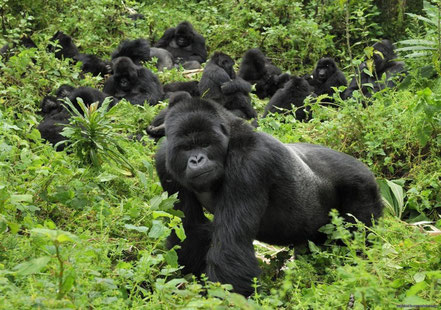what makes mountain gorillas unique

Mountain gorilla trekking can be conducted throughout the year in Uganda and Rwanda because of the damp seasons experienced by the national parks where mountain gorillas stay, though most tourists prefer to visit Uganda and Rwanda from June to September as well as from December to February.
What do mountain gorillas look like?
The male mountain gorillas are always twice the size of the females. Mountain gorillas usually weigh 350-500 pounds and grow up to 6 ft. click here to see mountain gorilla trekking safaris
Males are normally referred to as silver-backs because they grow hair on their backs that turn silver, the male ones are always stronger with long arms and muscular, silver’s arm can stretch for about 7 feet, Mountain gorilla life span takes between 40-50 years on this planet, they climb trees occasionally though mostly they stay on the ground, their offspring play in trees
The most enchanting fact about mountain gorillas is that they share up to 98% of their genetic composition with human beings
Mountain gorillas live in groups that differ in size, for example, from 2–30 or 40 members, but most commonly in groups of 10 members. These apes have no specific season for mating, meaning that babies are born throughout the year. Female mountain gorillas start giving birth as early as 10–12 years old, giving birth every 2-3 years to 4-6 offspring, while males start breeding at around 15 years and above.
Female gorillas have a gestation period of 8.5 months. It is always hard to identify a pregnant female gorilla since she is large enough to begin with (food digestion). Mountain gorilla offspring are usually born at night, with single infants and twins being rare incidents with a 40% mortality rate.
Where can one see mountain gorillas in Africa?
Gorillas can be seen in three African countries, namely Uganda, Rwanda, and the Democratic Republic of the Congo. Visitors should note that there are two types of gorillas. Congo has low-land gorillas with sub-species, while Uganda and Rwanda have mountain gorillas for climax views.
Background check on mountain gorillas
Endangered Uganda’s mountain gorillas don’t stay in zoos worldwide; they can’t stay in detention, and only those in national zoos are the lowland gorillas of West Africa. Bwindi Impenetrable National Park and Mgahinga Gorilla National Park have approximately half of the total world mountain gorilla population.
